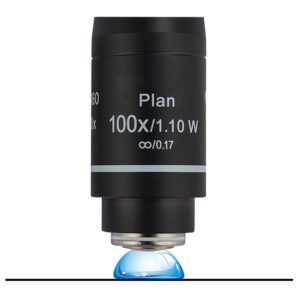What is Microscope Immersion Oil?
The objective lenses of a microscope can be categorized into dry objective lenses and immersion objective lenses. High magnification objective lenses (60X, 100X) often require immersion in water or oil to increase their numerical aperture (NA) value and resolution.
Water immersion objective lenses are typically marked with a “W”, as shown in the diagram. They utilize water as a medium filled between the front end of the objective lens and the cover slip, reducing refraction of light from the specimen to the objective lens. Such lenses are commonly used for observing live cells or specimens sensitive to immersion oil. Their advantages include simple operation and easy cleaning.
Oil immersion objective lenses require the addition of high refractive index immersion oil between the front end of the objective lens and the cover slip, which is relatively more complex. In this article, we will delve into the detailed discussion of the required immersion oil.
Why Do We Use Microscope Immersion Oil?
The purpose of using immersion oil with a microscope is to change the refractive index of light when observing specimens with high-magnification objective lenses. This alteration allows more light to enter the objective lens, thereby enhancing resolution and enabling clearer observation and research of the specimen.
The refractive index of light is the ratio of the speed at which light propagates in different mediums. For example, when light travels from one medium (such as glass) to another medium (such as air), the speed of light changes due to the difference in mediums, causing the direction of the light to also change. This phenomenon is called refraction. The refractive index is typically represented by 𝑛.
|
Medium |
Glass |
Air |
Water |
Immersion Oil |
|
Refractive Index |
1.5 |
1 |
1.33 |
1.515 |
The refractive index of glass is approximately 1.5, while the refractive index of air is around 1.0. When using high-magnification microscopes to observe specimens, the optical lenses typically use glass with a refractive index ranging from 1.65 to 1.78. Light passes through the cover slip to reach the objective lens. To minimize the refraction of light in air, it’s preferable for the refractive index of the medium used to be closer to that of glass. Immersion oil has a refractive index of 1.515, which serves as a medium to guide more light through the objective lens.
When observing specimens with low-magnification objective lenses, whose numerical aperture typically ranges from 0.05 to 0.95, the refractive effects are not as significant.

How Do We Use Microscope Immersion Oil?
Preparation:
Use professional cleaning tools to clean the objective lenses and eyepieces to ensure optimal observation results.
Apply immersion oil:
Drop an appropriate amount of immersion oil onto the microscope cover slip, ensuring complete coverage of the specimen without air bubbles. Excessive oil may contaminate the microscope or specimen, while too little oil may not fully achieve its intended effect.
Place the specimen:
Position the specimen on the stage, ensuring a moderate distance between the immersion oil objective lens and the specimen. Initially, use a low-magnification objective lens to focus on the specimen, being careful to avoid contact between dry objective lenses and the oil. Switch to the oil immersion objective lens and lower it until it contacts the oil.
Observe the specimen:
Adjust the focusing knob until the specimen is clearly visible.
Cleaning and maintenance:
After observation, promptly clean the immersion oil from the objective lens using professional lens paper or cleaning solution.
Types of Immersion Oil
Cedarwood Immersion Oil
Cedarwood oil is the most commonly used immersion oil medium, with a refractive index of 1.515, which is very close to that of glass. It significantly enhances the resolution of high-magnification objective lenses and is suitable for observing typical biological specimens.

Yellow Cedarwood Oil

Clear Cedarwood Oil
Silicone Immersion Oil
Silicone oil is suitable for high-temperature environments or situations requiring prolonged observation. It has a higher refractive index and chemical stability, making it less volatile. However, its cost is relatively higher compared to other immersion oils.
Fluorescence Immersion Oil
Special immersion oil mediums designed for fluorescence microscopy are utilized to minimize autofluorescence, ensuring the purity of fluorescence signals. They are suitable for observing various fluorescence-stained specimens.

Fluorescence Immersion Oil
Synthetic Immersion Oil
Compared to traditional immersion oils, synthetic oils can achieve a refractive index of up to 1.6 and cause less wear on objective lenses, making them widely used.
Tips
Avoid contamination:
Immersion oil is a pure liquid. When using immersion oil, avoid exposing it to dust, dirt, or other contaminants to prevent affecting its performance.
Prevent allergies:
Immersion oils are typically colorless and non-toxic, but some components may cause allergies in certain individuals. Conduct a skin test on the back of your hand before use.
Proper storage:
Store in a sealed container in a cool, dry place, away from direct sunlight and high temperatures.
Do not mix:
Different types of immersion oils mentioned above have different compositions and properties. It’s not recommended to mix them for use.












